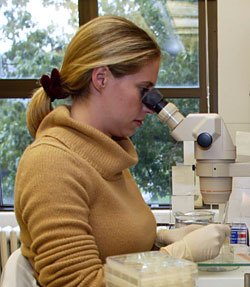First author of this paper, Antonia Holway
One of the 10 biological commandments is “Thou shall keep thy genome stable!” One way that proliferating cells accomplish this is to rely on cell cycle checkpoints to slow down the cell division cycle when their DNA is damaged. Checkpoints are signal transduction pathways that are activated by damage and that change the behavior of their downstream target, cell cycle proteins. During early development in many organisms, checkpoints lead a double life as developmental regulators. In C. elegans, for example, the checkpoint that normally responds to DNA damage responds instead to developmental signals and, by doing so, modulates the timing of the early embryonic cell division program. This control over cell cycle timing is critical for development, as alterations in the timing of cell division cause missegregation of developmentally important transcription factors and, ultimately, a failure to properly pattern the embryo. The importance of restricting checkpoint activation to developmental signals during early development is underscored by the observation that inappropriate checkpoint activation extends the early embryonic cell cycle and kills the embryo.
These observations led us to imagine the possibility of a checkpoint conflict during early development. Conflict could arise if damaged chromosomes activated the checkpoint in an inappropriate manner, leading to disruption of the timing of cell division and developmental disaster. Thus the goal of the featured study was: do checkpoints ignore DNA damage during early development and, if so, how?
The results of this study have just been published in theJournal of Cell Biology. The answer is that worm embryos have evolved a pathway that actively silences the checkpoint when DNA damage is present. An interesting feature of this silencing pathway is that it uses a translesion polymerase to silence the checkpoint. Translesion DNA polymerases have the capacity to use damaged DNA as a template, but cells pay a price for this in the form of mutations, as translesion polymerases make mistakes at high frequency when copying DNA. The utilization of a mutagenic form of damage bypass during checkpoint silencing highlights the importance of keeping the checkpoint quiet during an early embryonic damage response, as the embryo essentially trades mutations for continued progression through the cell cycle. Thus embryos appear to violate one of the 10 biological commandments, but by doing so they keep their cell cycles “on the clock” and thereby survive the damage crisis—even if their genomes look a little different for having done so.


